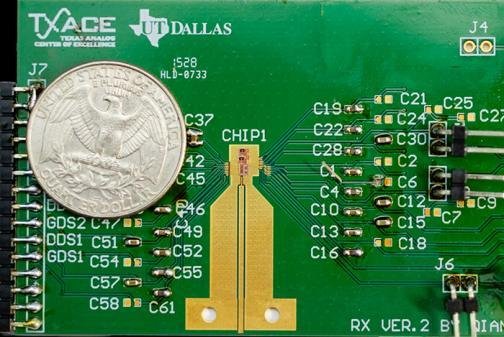Researchers determined that using integrated circuits, including one shown to the right of the United States quarter and below the label "CHIP1" in an electronic nose will make the device more affordable. Photo by University of Texas Dallas
DALLAS, June 16 (UPI) -- Scientists have devised an electronic nose that detects proteins in the breath and could make its way to to market for everything from DUI stops to detecting diabetes.
Using technology similar to cellphones could make the already existing ability affordable enough for wider use, say scientists at the University of Texas in Dallas, who hope it can be applied to a wide range of uses.
The artificial nose has been pursued for diagnosis of disease, as well as for law enforcement to use in DUI stops in states that have legalized marijuana, though the technology to do so has thus far been bulky and expensive.
The scientists propose using CMOS integrated circuits, used in smartphones and tablets, to reduce manufacturing costs so they could be used more widely.
"We are excited by the possibilities of the new technology and are working to rapidly explore its uses and applications," Dr. David Yeh, senior director at the Semiconductor Research Corporation, one of the companies working to develop the technology with the University of Texas scientists, said in a press release. "It is a significant milestone, but there is still much more research needed for this to reach its potential."
The concept, outlined in a paper published before its presentation by the scientists at the 2016 IEEE Symposia on VLSI Technology and Circuits, lays out a design using a rotational spectrometer that generates and transmits electromagnetic waves over various frequencies, analyzing the waves to detect chemical concentrations.
The "electronic nose" detects more gas molecules with greater specificity and sensitivity than a Breathalyzer. The significance of this, the scientists say, is that acetone is not confused for ethanol -- patients with type 1 diabetes have high concentrations of acetone in their breath, while ethanol is found on the breath of people who have consumed alcohol.
Over the long term, the scientists expect the device would move from industrial and legal uses to doctors' offices and hospitals, eventually making it into homes where it may eventually able to detect diseases earlier based solely on gases people exhale.
"If you think about the industry around sensors that emulate our senses, it's huge," said Dr. Kenneth O, a professor in the Erik Jonsson School of Engineering and Computer Science at the University of Texas. "Imaging applications, hearing devices, touch sensors -- what we are talking about here is developing a device that imitates another one of our sensing modalities and making it affordable and widely available. The possible use of the electronic nose is almost limitless. Think about how we use smell in our daily lives."















